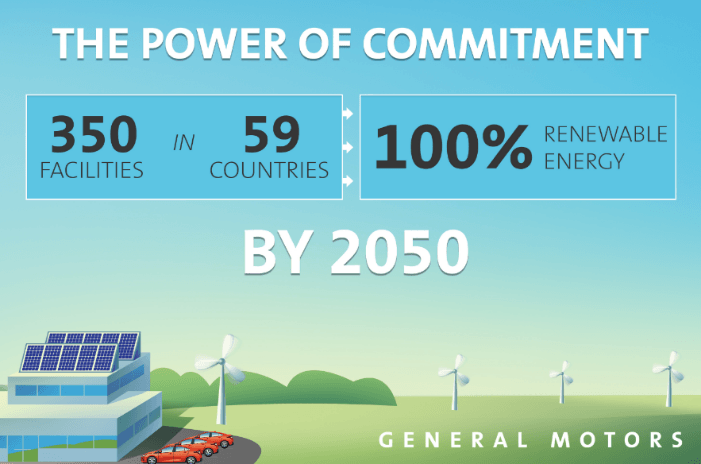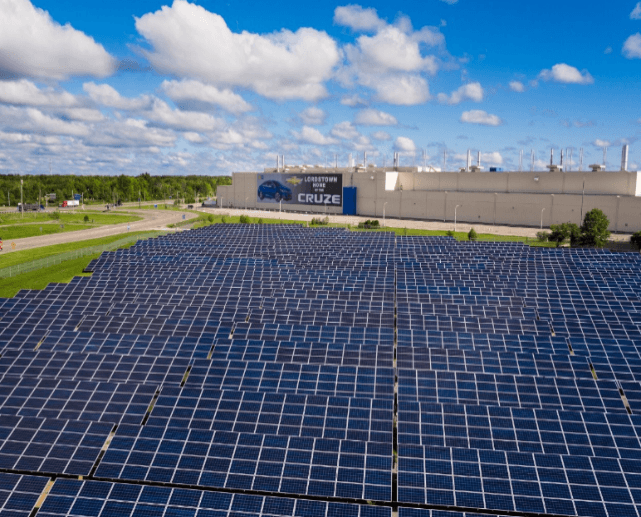A Story Retold: General Motors Sets Sight on Leadership in Energy Efficiency Again

General Motors is attempting to retell its sustainability story. Instead of focusing solely on fuel efficiency, the company is heavily emphasizing its operational sustainability efforts.
Global climate change and its connection to anthropogenic greenhouse gases is gaining widespread awareness, and a usual suspect of blame is the automobile industry. Customers are increasingly valuing vehicles that not only have better performance, safety equipment, and luxury features, but that also have better fuel efficiency. While the connection between driving and the greenhouse effect is visible to drivers, behavior is barely changing due to the premium on renewable energy-based cars and lower oil prices.[1] Frankly, gas guzzling cars still sell well.
As a result, automobile companies are in a dilemma of how to change their production priorities towards fuel efficiency for a relatively weak fuel efficient automobile market.[2] In addition to customer perception, regulation to curb fuel emissions are an added stress to automobile companies. Regulation, in the form of maximum output standards and emission taxes on car producers, limits vehicle CO2 emissions, and other toxic substance emissions such as carbon monoxide (CO), hydrocarbons (HC), and nitrogen oxides (NOX).[3]
General Motors was one of the first car companies to introduce a fuel efficient vehicle. In the late 1990s, the company introduced the option to lease a Chevy EV1, an electric car that was adored by customers.[4] When the company suddenly cancelled EV1 production plans despite strong consumer demand, the press and general public were outraged (EV1 fans even held a candlelight vigil for the car!). Regardless of the real reason why GM cancelled EV1 production, GM received a load of negative press coverage that claimed the company colluded with oil companies and was suppressing electric vehicles from coming to market.[5] As Toyota eventually released the Prius and regulation sought to curb energy inefficiencies, GM, known for Hummer and other large gas guzzlers, was forced to reprove to the press, consumers, advocacy organizations, and the government, that it was ready to embrace sustainability efforts.[6]
A Pivot from a Fuel-Efficiency Focus to an Operations-Based Sustainability Strategy
In an effort to eradicate company associations with gas guzzling cars and conspiracy theories related to the beloved EV1, GM CEO, Mary Barra, has committed to fuel efficiency in the company’s production line.[7] This effort is publicized through GM’s Chevy Volt, a plug-in battery-operated vehicle. Instead of relying solely on press coverage concerning fuel efficiency and product comparability with competitive companies, GM has decided to reorient emphasis on sustainability towards its production facilities. Barra has put GM at the forefront of climate change press coverage, as she has articulated a strategy for GM to “run entirely on renewable energy by 2050.”[8]
What Does This Mean?
GM runs 350 operations across the globe, and has vowed to generate its electricity solely through renewable sources.[9] Last year, GM used 9 terawatt hours of energy to build its automobiles and supply power to its facilities.[10] The new strategy has provided for lower and more stable energy costs (GM has saved $5 million a year from using renewables), while at the same time, benefiting customers and communities through cleaner air.[11] Currently, the company has already converted 22 of its sites to using solar power and 4 of its sites to using wind as a power source. [12]
GM has dedicated significant company press coverage to its operational efforts to promote sustainability. The company has also published an extensive sustainability report that is on the United Nations Global Compact website. This report mentions fuel efficiency efforts, but also goes into much detail regarding operational and supply chain environmental changes.[13]
Is GM’s Operations-Oriented Sustainability Strategy Genuine and Strong Enough to Sway Consumer Perception?
GM has undertaken a bold strategy to put itself at the forefront of operational sustainability efforts in the automobile sector. The company is gaining recognition from the United Nations and various climate change advocates for its new emphasis on operations, however, is this strategy enough to detract focus from its tainted history related to the EV1? [14] Can this operation-based strategy and increased press coverage convince consumers that the company is truly environmentally-conscious while the company continues to remain heavily involved with the production of the quintessential gas guzzling vehicles?
It remains to be seen how many millions of vehicles in GM’s production line are powered by sustainable energy in the coming years.
Word Count: 794 words
[1] The Automotive Industry and Climate Change. PwC, 2007. http://www.pwc.com/th/en/automotive/assets/co2.pdf
[2] Ibid.
[3] Fletcher, Seth. Bottled Lightning: Superbatteries, Electric Cars, and the New Lithium Economy. New York, D&M Publishers, 2011.
[4] Ibid.
[5] Ibid.
[6] Ibid.
[7] “Automotive CEOs Rally for Clean Vehicles.” General Motors, 14 Dec. 2015. www.generalmotors.green/product/public/us/en/GMGreen/home.detail.html/content/Pages/news/us/en/gm_green/2015/1214-wef.html.
[8] Agerholm, Harriet. “General Motors Vows to Run Entirely on Renewable Energy by 2050.” The Independent, 15 Sept. 2016. www.independent.co.uk/news/world/americas/general-motors-renewable-energy-pledge-promise-2050-cut-carbon-emissions-climate-change-a7309701.html.
[9] Ibid.
[10] Ibid.
[11] Ibid.
[12] Ibid.
[13] GM 2015 Sustainability Report. General Motors, 2015. https://www.unglobalcompact.org/system/attachments/cop_2016/331541/original/GM_2015_Sustainability_Report.pdf?1477685598
[14] “GM Gets Perfect Climate Change Disclosure Score from CDP.” General Motors, 16 Nov. 2015. www.generalmotors.green/product/public/us/en/GMGreen/home.detail.html/content/Pages/news/us/en/gm_green/2015/1116-cdp.html.





I would be curious to know more about GM’s energy procurement practice. As GM does not produce energy, it has to rely on suppliers that can provide energy coming from “renewable” sources in many countries across the globe. Yet, the term “renewable” could be defined in many different ways based on the countries’ regulations. For instance, nordic countries are known to define “renewable” in a much more conservative way than certain developing economies. Hence, I believe that the company should audit and certify not only its own facilities but also its suppliers’ operations.
Great blog post, Ranjani! I once watched a documentary on the death of the EV1 vehicle mentioned in your post, and while I agree that GM is trending in the right direction with the increasing focus on sustainability in its operations, I think they have dug a fairly deep hole from which to climb out. It will take more than the Chevy Volt and overhauling the supply chain to be acknowledged as a sustainability leader. Fortunately, GM is also arguably tackling sustainability from the technology angle with its $500m investment in Lyft in April of this year (http://media.gm.com/media/us/en/gm/news.detail.html/content/Pages/news/us/en/2016/Jan/0104-lyft.html). Companies like Lyft ultimately reduce the number of cars needed on the road, and result in greater car utilization through offerings like Lyft Line.
I think the big sustainability challenge for GM is going to be the tension between sustainability efforts and shareholder return. $5m of cost savings from sustainability initiatives is not a big number (almost a rounding error!) for a big company like GM. And even initiatives like the Lyft partnership are ultimately going to result in lower amount of vehicle sales, though they may boost them in the short-term through leasing partnerships with drivers. The Big 3 manufacturers including GM have underperformed in recent years, so this tension is likely to be magnified.
Despite the long term tension though, I think GM should accelerate down the path it’s started with Lyft and make more investments that make the overall auto ecosystem more sustainable. Though GM may not be rewarded in its income statement for these efforts, it will acquire valuable assets that may keep it relevant a la Yahoo and Alibaba, even if the company continues to underperform.
Prior to reading this, I did not know that GM formerly had an electric car – especially not one that was launched nearly two decades ago, too! It truly is a shame that they gave up the opportunity to be the first mover in this space, and now left to eat the dust of the likes of Toyota Prius and Tesla Motors. Upon doing some research on the sales figures of the Toyota Prius vs the Chevy Volt, I found that Toyota sold approximately six times more units in a single month. This underscores how costly a bad decision can be.
In addition to the Chevy Volt you mentioned, GM has recently announced the launch of the Chevy Bolt EV (it’s first purpose-built regular production electric car since the demise of the EV1 17 years ago) in early 2017. On paper, the Bolt looks slated for success – it can go up to 238 miles on a single charge, and is affordably priced at around $30,000 (after tax rebates). However, I would argue that the true test of the success of GM’s commitment to sustainability would be how GM’s management team reacts if sales of the Bolt prove to be consistently lacklustre.
This is a great article that highlights another valiant effort by a major US auto manufacturer to address the issue of climate change. While I agree with GM’s strategy to reach its 2050 goal, I believe the company could go one step further by engaging and holding their suppliers to the same set of standards. As this Car And Driver article (http://blog.caranddriver.com/the-business-behind-gms-pledge-to-use-only-renewable-energy-by-2050/) mentions, GM should ensure its suppliers are also committed to the effort of reducing greenhouses gases through their operations. If GM begins to openly discuss how it is engaging its entire supply chain in its environmental efforts, it can certainly convince consumers that the company is conscious about its impact on the environment. Furthermore, it would allow GM to continue being a leader in auto industry’s efforts to combat global warming. It would be equally impactful for GM to find ways that incorporate consumers’ thoughts around how its products can become better suited to reduce emissions and to help GM reach its 2050 goal.